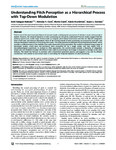Understanding pitch perception as a hierarchical process with top-down modulation.
| dc.contributor.author | Balaguer-Ballester, E | en |
| dc.contributor.author | Clark, NR | en |
| dc.contributor.author | Coath, M | en |
| dc.contributor.author | Krumbholz, K | en |
| dc.contributor.author | Denham, SL | en |
| dc.date.accessioned | 2017-05-26T08:30:41Z | |
| dc.date.available | 2017-05-26T08:30:41Z | |
| dc.date.issued | 2009-03-06 | en |
| dc.identifier.uri | http://hdl.handle.net/10026.1/9360 | |
| dc.description | PMCID: PMC2639722 | en |
| dc.description.abstract |
Pitch is one of the most important features of natural sounds, underlying the perception of melody in music and prosody in speech. However, the temporal dynamics of pitch processing are still poorly understood. Previous studies suggest that the auditory system uses a wide range of time scales to integrate pitch-related information and that the effective integration time is both task- and stimulus-dependent. None of the existing models of pitch processing can account for such task- and stimulus-dependent variations in processing time scales. This study presents an idealized neurocomputational model, which provides a unified account of the multiple time scales observed in pitch perception. The model is evaluated using a range of perceptual studies, which have not previously been accounted for by a single model, and new results from a neurophysiological experiment. In contrast to other approaches, the current model contains a hierarchy of integration stages and uses feedback to adapt the effective time scales of processing at each stage in response to changes in the input stimulus. The model has features in common with a hierarchical generative process and suggests a key role for efferent connections from central to sub-cortical areas in controlling the temporal dynamics of pitch processing. | en |
| dc.format.extent | e1000301 - ? | en |
| dc.language | eng | en |
| dc.language.iso | eng | en |
| dc.subject | Auditory Perception | en |
| dc.subject | Feedback | en |
| dc.subject | Humans | en |
| dc.subject | Models, Theoretical | en |
| dc.subject | Music | en |
| dc.subject | Speech | en |
| dc.title | Understanding pitch perception as a hierarchical process with top-down modulation. | en |
| dc.type | Journal Article | |
| plymouth.author-url | http://www.ncbi.nlm.nih.gov/pubmed/19266015 | en |
| plymouth.issue | 3 | en |
| plymouth.volume | 5 | en |
| plymouth.journal | PLoS Comput Biol | en |
| dc.identifier.doi | 10.1371/journal.pcbi.1000301 | en |
| plymouth.organisational-group | /Plymouth | |
| plymouth.organisational-group | /Plymouth/PS - Doctoral College | |
| plymouth.organisational-group | /Plymouth/REF 2021 Researchers by UoA | |
| plymouth.organisational-group | /Plymouth/REF 2021 Researchers by UoA/UoA04 Psychology, Psychiatry and Neuroscience | |
| plymouth.organisational-group | /Plymouth/Research Groups | |
| plymouth.organisational-group | /Plymouth/Research Groups/Centre for Brain, Cognition and Behaviour (CBCB) | |
| plymouth.organisational-group | /Plymouth/Research Groups/Centre for Brain, Cognition and Behaviour (CBCB)/Brain | |
| plymouth.organisational-group | /Plymouth/Users by role | |
| dc.publisher.place | United States | en |
| dc.identifier.eissn | 1553-7358 | en |
| dc.rights.embargoperiod | Not known | en |
| rioxxterms.versionofrecord | 10.1371/journal.pcbi.1000301 | en |
| rioxxterms.licenseref.uri | http://www.rioxx.net/licenses/all-rights-reserved | en |
| rioxxterms.type | Journal Article/Review | en |


